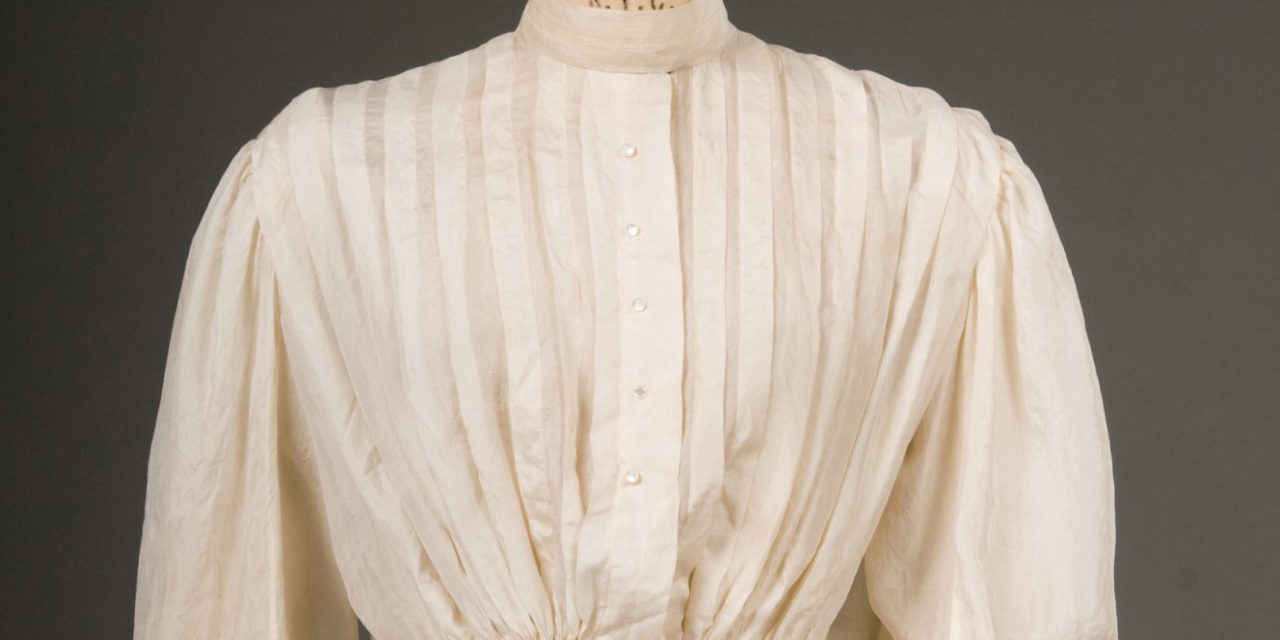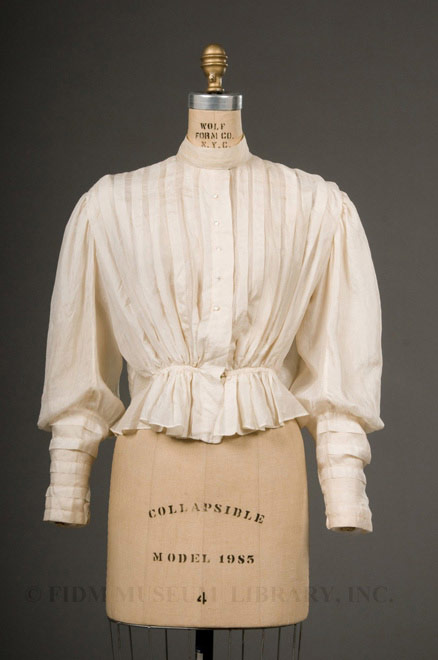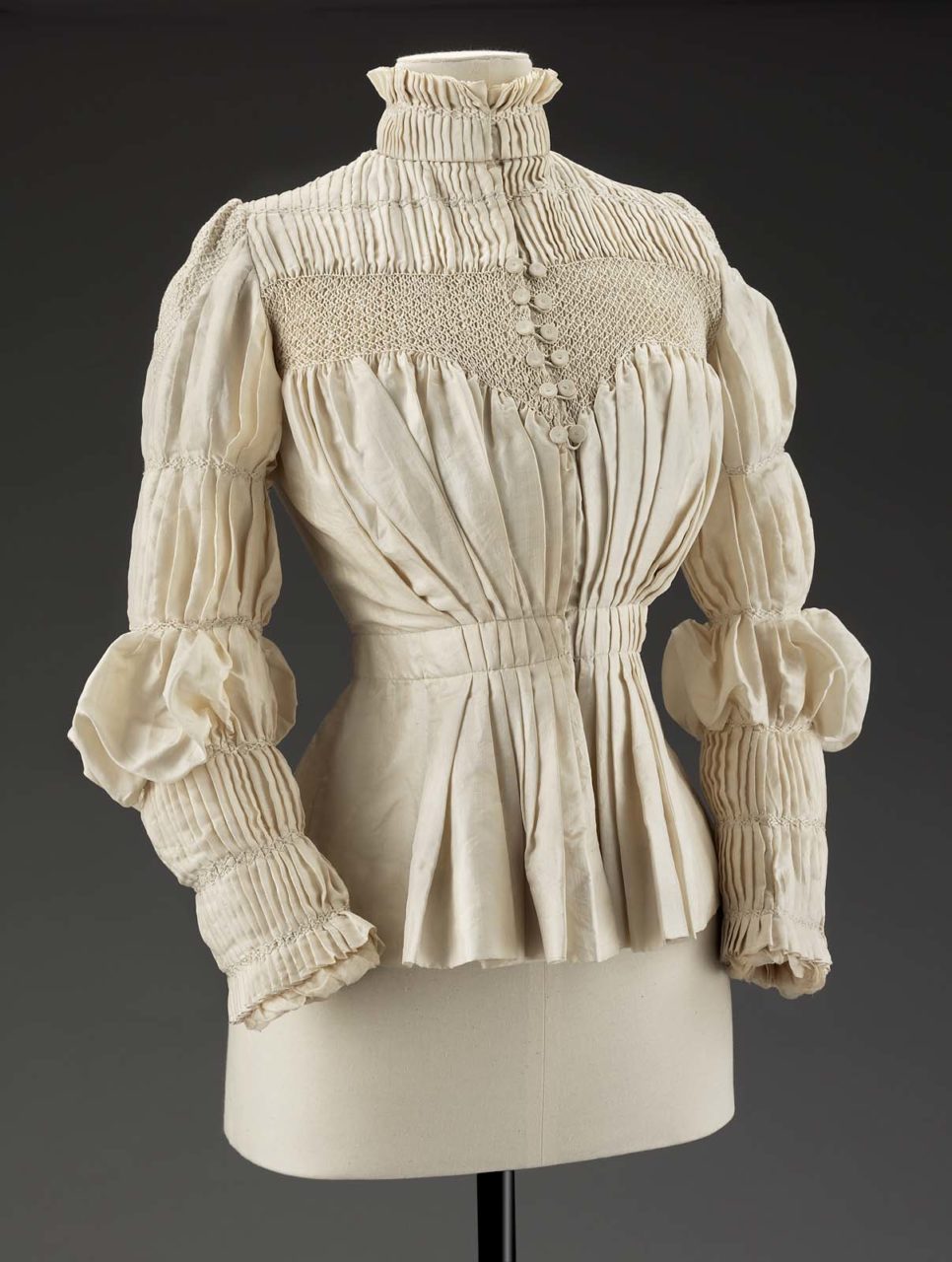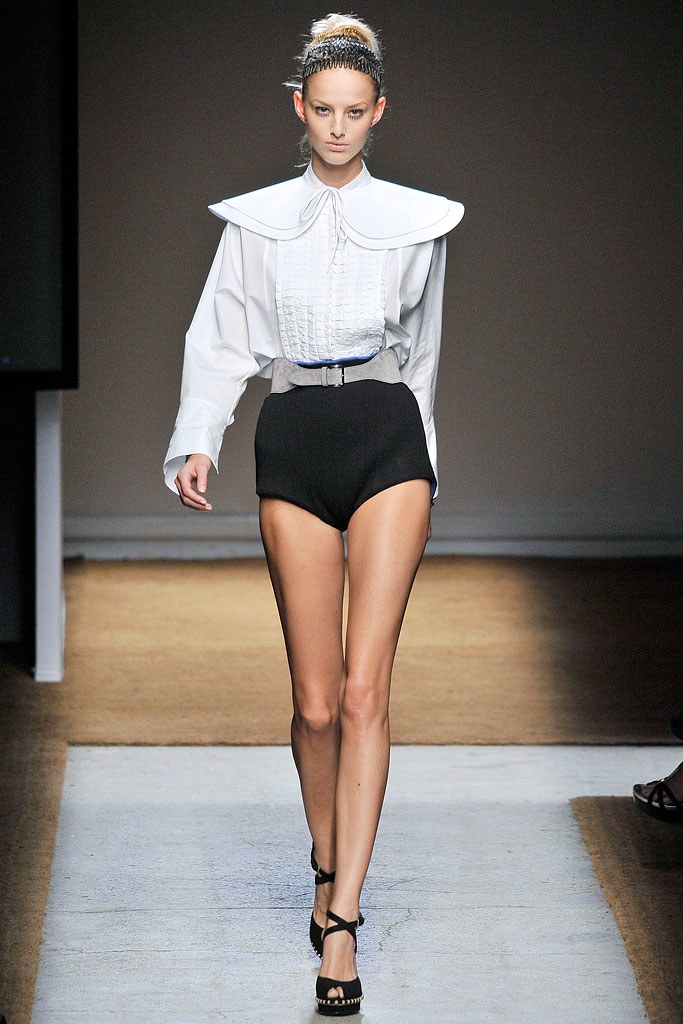Also known as waist; a woman’s blouse that resembles a man’s shirt.
The Details
Charlotte Mankey Calasibetta and Phyllis Tortora define the shirtwaist in Dictionary of Fashion (2002) as:
“1. Any blouse cut similarly to a contemporary man’s shirt. 2. Term originating in 1890s for women’s blouses styled like men’s shirts with buttons down front, tailored collar, and sometimes worn with black tie. 3. A woman’s blouse with a high choker neckline buttoned in back- one of the first items produced by the ready-to-wear industry.” (37)
Of Figure 1, the Fashion Institute of Design and Merchandising Museum writes:
“This shirtwaist from our collection is constructed from a lightweight, almost sheer cream silk. Though a shirtwaist indicated a slightly relaxed mood, it would have been worn with the requisite undergarments: a chemise and corset. The sleeves, full in the shoulder and close-fitting at the lower arm, are typical of the early-to-mid 1890s. During this decade, sleeve fullness and variation were a noted characteristic of women’s garments. Because shirtwaists were always tucked neatly into a skirt, the front pleats are gathered into a waist-level band. This clever construction trick would have helped the wearer keep her pleats tidily in place.”
Kristina Haugland writes of the transformative effect of the shirtwaist on womenswear in the Encyclopedia of Clothing and Fashion (2005):
“By the 1890s, these bodices, now called shirtwaists or waists, had indeed dramatically increased the average woman’s clothing options. Shirtwaists could be severely tailored with masculine-style detachable starched collars and cuffs, or very feminine in lightweight fabrics trimmed with lace, insertion, and other lavish decoration. Shirt-waists were suitable with tailored suits, with a skirt for housework and sportswear, and with bloomers for cycling or as gym costumes, while dressier versions were worn for afternoon receptions, the theater, and evening wear.” (163)
Of Figure 3, the Museum of Fine Arts in Boston states that this shirtwaist was designed by Liberty & Co., a “well-known purveyor of fine fabrics and eastern wares.” The company opened a costume department in 1884 and this was one of their garments. The MFA elaborates:
“Ivory pleated blouse with a V-shaped smocked bib at the bustline front, back, and shoulder caps. High necked self ruffled released pleat collar with interior braid, peplum waistband, set in Elizabethan shaped sleeves with graduated puffs stitched down by narrow rows of smocking stitches; with silk gauze cuff ruffle and self covered flat buttons with figure eight loop closures down the center front. Labeled: ‘Liberty & Co./Artistic and Historic Costume Studio/222 Regent St. W.’ Labeled ‘Davis &co. 143’.”
Phyllis Tortora and Keith Eubanks write in A Survey of Historic Costume (1989):
“Shirtwaists–or “waists” were made in styles ranging from blouses with leg-o-mutton sleeves tailored to look like a man’s shirt to style covered with lace, embroidery and frills.” (262)
Figure 4 depicts what a typical leg-o-mutton sleeve shirtwaist looks like. The fabric is gathered at the upper arm and tight from the elbow to the wrist.
Of Figure 5, the Museum at FIT writes:
“In the late nineteenth century, inexpensive ready-to-wear like this shirtwaist made fashion accessible to greater numbers of people. However, increased factory mass production brought with it a host of concerns, including pollution and poor labor practices. Unions were formed to combat low wages, extremely long hours, and the often unsafe conditions faced by garment workers.”
Fig. 1 - Designer unknown. Shirtwaist, ca. 1890-1899. Silk. Los Angeles: Fashion Institute of Design and Merchandising Museum & Galleries, 2003.793.7AB. Gift of Ann Jensvold. Source: FIDM Museum
Fig. 2 - Designer unknown (American). Shirtwaist, 1890s. Cotton, linen. New York: The Metropolitan Museum of Art, C.I.56.16.19a–d. Gift of Mrs. Wanamaker Munn, 1956. Source: The Met
Fig. 3 - Liberty & Co. (English). Woman's blouse, 1890s. Silk plain weave; bust: 66 cm, waist 58.4 cm (bust: 26 in waist: 23 in). Boston: Museum of Fine Arts, 2006.1180. Frank B. Bemis Fund. Source: MFA Boston
Fig. 4 - Designer unknown (American). Woman's shirtwaist, ca. 1896. Silk plain weave; center back length 44.5 cm (center back length 17 1/2 in). Philadelphia: Philadelphia Museum of Art, 1969-56-20. Gift of Miss Elinor E. Curwen and Mrs. Edward F. McKeen, 1969. Source: Philadelphia Museum of Art
Fig. 5 - Stanley (American). Shirt, ca. 1894. Cotton. New York: The Museum at FIT, P91.33.1. Museum purchase. Source: The Museum at FIT
Its Afterlife
During the Spring 2010 Ready-to-Wear Saint Laurent show (Fig. 6) and the Fall 2013 Ready-to-Wear Aganovich (Fig. 7) showed inspiration from the shirtwaist blouse. The Saint Laurent piece is gathered at the waist and has a white tie. The Aganovich piece has similar sleeves to the leg-o-mutton sleeves.
Fig. 6 - Saint Laurent. Ready-to-Wear, Spring 2010. Source: Vogue
Fig. 7 - Aganovich. Ready-to-Wear, Fall 2013. Source: WWD
References:
- “1890s Shirtwaist.” FIDM Museum Blog. Accessed September 27, 2017. http://blog.fidmmuseum.org/museum/2010/09/1890s-shirtwaist.html.
- Calasibetta, Charlotte Mankey, Phyllis G. Tortora, Charlotte Mankey Calasibetta, and Publications Fairchild. The Fairchild Dictionary of Fashion. 3rd ed. New York: Fairchild Publications, 2003. http://www.worldcat.org/oclc/904557113.
- Haugland, H. Kristina. “Blouse.” Encyclopedia of Clothing and Fashion 1 (November 30, 2004): 163–64. http://libproxy.fitsuny.edu:2200/ps/i.do?p=GVRL&sw=w&issn=&v=2.1&it=r&id=GALE%7CCX3427500079&sid=googleScholar&linkaccess=abs.
- “Philadelphia Museum of Art – Collections Object : Woman’s Shirtwaist.” Accessed September 27, 2017. http://www.philamuseum.org/collections/permanent/180721.html?mulR=223520509|2.
- “Shirtwaist » Womenswear » Collections » FIDM Museum and Galleries » FIDM/Fashion Institute of Design and Merchandising.” Accessed September 27, 2017. http://fidmmuseum.org/collections/womenswear/item/2003-793-7ab.html.
- “Shirtwaist » Womenswear » Collections » FIDM Museum and Galleries » FIDM/Fashion Institute of Design and Merchandising.” Accessed September 27, 2017. http://fidmmuseum.org/collections/womenswear/item/2003-793-7ab.html.
- “The Museum at FIT – Online Collections.” Accessed September 27, 2017. http://fashionmuseum.fitnyc.edu/view/objects/asitem/759/10/dynasty-desc?t:state:flow=a89ede87-1e97-4fdd-bdc2-c01b88dfdbcc.
- “Woman’s Blouse.” Museum of Fine Arts, Boston, April 15–15, 2017. http://www.mfa.org/collections/object/womans-blouse-482317.

















